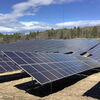Rate shock spurs closer look at energy efficiency for Maine businesses
A year ago, Mountain Machine Works CEO Bruce Tisdale struggled with whether it made sense to sign a long-term contract to lock in the electricity rate for his Auburn-based machine shop over the next four years. Other options included settling for the standard offer price set each year by the Maine Public Utilities Commission in a competitive-bid process, negotiating yearly contracts with the electricity supplier he already had, or finding a better deal with someone else.
In the end, his fear that the locked-in rate could end up higher than the alternatives was trumped by a nagging feeling the volatility of New England's electricity market more likely would drive the “supply” cost of his electricity bill into the unaffordable territory for his business. He signed the contract, locking his electricity rate at just under 7 cents per kilowatt hour for four years.
“That's a great deal, but it's more than what the standard offer price was just before we signed the contract,” Tisdale says.
Turns out he made the right bet.
The price of electricity for Maine businesses will skyrocket this winter — with medium-sized commercial and industrial customers in Central Maine Power's territory seeing the supply portion of their electric bill jump from 6 cents/kWh in October to 15 cents/kWh in January. Emera Maine's rates for the same group of customers will rise from 6 cents to 16 cents/kWh. The principal cause of those alarming price increases is the high cost of natural gas delivered to New England in the winter months, which translates into higher prices for the region's gas-fired electricity-generating plants or greater use of generators powered by more expensive coal or oil.
It's the first time since 2008 that the standard offer price of electricity for medium-sized businesses will go above 14 cents/kWh, and that's prompting state energy officials to encourage Maine businesses to make the energy-efficiency investments that will moderate the impact of those price increases.
Otherwise, in the scenario provided in a joint press release issued this fall by the PUC, the Governor's Energy Office, Efficiency Maine and the Maine Public Advocate's Office, the typical medium-sized business customer can expect to see the electricity supply portion of their bill jump from $870 per month in September to more than $2,000 per month in January.
Duly warned
Not surprisingly, the Oct. 6 announcement prompted more than a few Maine businesses to call Patrick Woodcock, director of the Governor's Energy Office, asking if anything could be done about those skyrocketing electricity rates. Woodcock readily admits there's no simple answer, but says the release had the desired result of alerting Maine businesses to a serious long-term problem while highlighting some immediate steps they might take to better manage the price increases and reduce their electricity costs.
“The only thing that's worse than a bill that's higher than expected is one that's higher and completely unexpected,” he says. “People are fearful. They wonder how their business can survive something like this … The first thing I tell them is that this is a winter issue — that prices will come down.”
Beyond that quick assurance, Woodcock says he's been giving a two-fold answer to those alarmed callers.
In the short term, Woodcock says, he points out that there are immediate steps businesses (as well as homeowners) can take to reduce their exposure to high electricity prices this winter and for years to come. Among them:
• Compare rates among electricity providers to get the best deal.
• Take advantage of Efficiency Maine discounts and rebates on high-efficiency fluorescent and LED lights, which can cut electricity usage by as much as 75%.
• Install lighting controls to ensure lights are on only when they're needed.
• Look into financial incentives available through Efficiency Maine that will speed the payback on high-efficiency air compressors, commercial refrigerators, heat pumps and other projects eligible for incentives that can reduce electricity costs.
• Consider shifting some operations to non-peak demand periods when electricity costs are lower.
Those steps and others, he says, can mitigate the spike in electricity costs this winter and reduce electricity costs even when the supply rates go down in the warmer weather months.
In the long term, Woodcock says, he'll be working with energy officials from the six New England states to revive a two-track regional energy infrastructure initiative calling for: 1) Investing in natural gas pipelines to remove the supply constraints that contribute to New England's higher natural gas and electricity costs; 2) Importing Canadian hydropower from Hydro-Quebec, which would require new transmission lines and, in Maine, would require the Legislature to agree to lift a 100-megawatt cap on renewable sources of energy.
Those initiatives, which Woodcock says are strongly supported by Gov. Paul LePage, stalled in August when Massachusetts Gov. Deval Patrick told the other New England governors his administration needed more time to evaluate various energy scenarios, including some that did not require building new natural gas pipelines. But a grim ISO New England forecast issued in November projects chronic regional shortfalls of natural gas supply, putting a strain on both electric power generators and residential and business heating customers in winter months through at least 2020. With an incoming Republican governor in Massachusetts, Gov.-elect Charlie Baker, Woodcock expects the stalled initiatives to get new life.
“If anything, the severity of the problem has grown,” Woodcock says. “This isn't hyperbole. This energy situation is a real problem. It's a regional problem that will require regional energy infrastructure investments.”
Short-term solutions, long-term benefits
Efficiency Maine Executive Director Michael Stoddard says that he, too, has fielded calls from businesses concerned about the coming rate spike.
“They're beating a path to our door, and that's great,” he says. “Here we are in mid-November and we're seeing record numbers of businesses taking advantage of our programs. When you see businesses making investments in energy-efficient equipment, it shows they are committed to doing business in the state. And it positions them to be even more competitive in the global economy by reducing their long-term energy costs.”
Efficiency Maine offers a number of incentive programs for businesses making investments in energy-efficient LED lighting; heating, ventilation or air conditioning; commercial refrigeration; and other energy-saving projects.
Stoddard says businesses of all sizes can benefit by investing in energy efficiency. Efficiency Maine's Business Incentive Program in the last fiscal year created annual savings of more than 38 million kWh for participating businesses. Avoided energy costs over the lifetime of the investments were pegged at $39.5 million, with a benefit-to-cost ratio of 2.89.
At Mountain Machine Works, Tisdale says that in addition to negotiating a long-term fixed-rate contract with his electricity supplier to reduce costs, he invested approximately $60,000 two years ago to make his Auburn machine shop more energy efficient. He hired Optimal Energy Group LLC, a Sumner company that completed an audit of his facility that included an analysis of its energy bills and provided recommendations with approximate savings. The investments he made included switching to more energy-efficient lighting, installing variable speed motors and reducing energy losses in his duct system.
“If I hadn't done this project, there's no question my kilowatt-hour usage would be a lot higher right now,” Tisdale says. “The project was a huge success for me.”
Lawrence O'Rourke, a principal of Optimal Energy Group, says his engineering company has been helping medium-to-large businesses in Maine reduce their energy costs since 2009. He says installing energy-efficient lighting is almost universally the “low-hanging fruit” project that will help any business reduce electricity costs, in some cases by 30% to 50%. Another common recommendation, he says, involves “right-sizing” HVAC systems.
“It's pretty typical to find facilities where the equipment they have delivers way more than what's really needed,” he says.
O'Rourke says his company, which is listed among Efficiency Maine's “qualified partners,” has been busy this fall making presentations at chambers of commerce across the state.
“The rate increase that's coming in January is really staggering,” he says. “There is no short-term solution other than conserving as much energy as possible … We're all going to be staring at this issue for the next four or five years, maybe longer.”
PUC chairman's perspective
PUC Chairman Thomas Welch, who's retiring at the end of the year, two years before his term expires, played a key role in the deregulation of the electricity industry in Maine in the 1990s during an earlier stint as PUC chairman. A strong advocate of expanding natural gas capacity within the state, Welch agrees with Woodcock that eliminating New England's natural gas bottleneck with added pipeline capacity outside of Maine would reduce energy costs.
“If you add pipeline capacity, everyone in New England benefits,” he says, explaining that when demand for natural gas to heat homes and businesses occurs at the same time that power plants need it for their electricity generators, the resulting supply shortfalls drive prices up on both fronts. Eliminate the shortfalls and prices should go down.
ISO New England, the nonprofit corporation that operates New England's electric power system, reports as much as 45% of New England's electricity now comes from natural-gas-powered generators. That's expected to increase to 48% by 2017 and 52% by 2023 — driven, in part, by the planned closures of the Vermont Yankee nuclear power plant at the end of this year and the coal-fired Brayton Point power plant in Massachusetts by 2017.
In its latest forecast of the region's energy needs through 2023, ISO New England expects the shortfalls and price spikes will worsen if nothing is done to improve the flow of natural gas into the region: “Operational challenges year round, particularly during peak winter electric power demand periods, are likely to become more severe as gas consumption by electric power generating units continues to grow … More expansion will most likely be required.”
“I think ISO is painting a pretty accurate picture,” Welch says. “I think their prognosis is accurate.”
But Welch says he's optimistic Maine and the rest of New England will solve the natural gas supply problems while continuing to increase consumer options for buying heat and electricity at affordable prices.
“This is a temporary problem and we're working very hard to fix it,” he says. “For businesses that take advantage of some of the programs that are available to improve their energy efficiency, that will put them in a very strong position once this problem is solved.”
Read more
Move over, Mississippi. Maine's on the rise












Comments